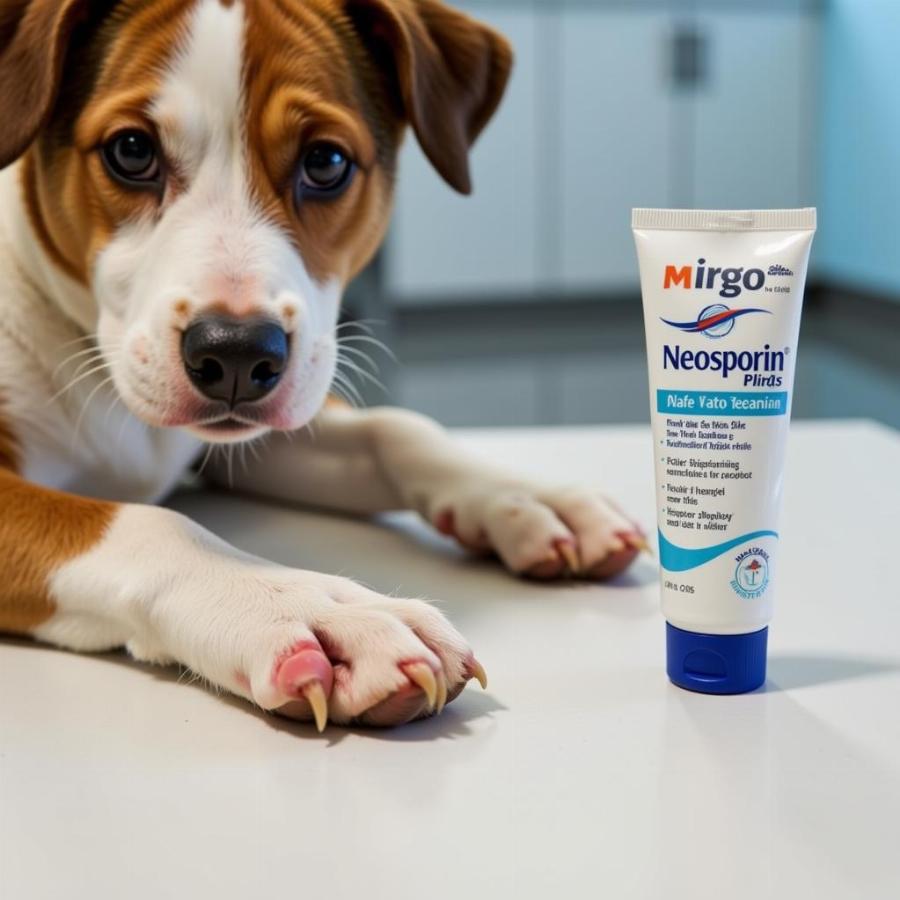Neosporin is a common household item found in many medicine cabinets. But does Neosporin work on dogs? It’s a question many dog owners ask, especially when their furry friend gets a minor cut or scrape. While Neosporin can be used in certain situations, it’s crucial to understand the dos and don’ts to ensure your dog’s safety. This article will delve into the specifics of using Neosporin on dogs, exploring when it’s appropriate, when it’s not, and safer alternatives.
Understanding Neosporin and Its Use on Dogs
Neosporin is a topical antibiotic ointment containing neomycin, polymyxin B, and bacitracin. These ingredients work together to kill bacteria and prevent infection in minor wounds. While generally safe for humans, its use on dogs requires careful consideration. The primary concern with Neosporin and dogs lies in potential allergic reactions and ingestion.
 Neosporin cho chó cảnh
Neosporin cho chó cảnh
When Can You Use Neosporin on Dogs?
Neosporin can be used on dogs for very superficial wounds, such as small cuts, scrapes, or abrasions. It’s essential to ensure the wound is clean and not deep or infected. Apply a very thin layer of Neosporin to the affected area only.
When Should You Avoid Using Neosporin on Dogs?
Avoid using Neosporin on deep wounds, puncture wounds, or bites. These types of injuries require veterinary attention. Also, never use Neosporin on areas where your dog can easily lick it off, such as on their paws or face. Ingestion of large amounts of Neosporin can cause gastrointestinal upset. If your dog shows signs of an allergic reaction, such as redness, swelling, or itching, discontinue use immediately and consult your veterinarian.
Safer Alternatives to Neosporin for Dogs
Several safer alternatives to Neosporin are specifically designed for use on animals. These products are formulated to minimize the risk of adverse reactions and are less likely to cause upset stomachs if ingested.
Pet-Specific Antibiotic Ointments and Sprays
Veterinary-approved antibiotic ointments and sprays are readily available and are a better choice than Neosporin for treating minor wounds on dogs. These products are often formulated with ingredients that are safe for animals and less likely to cause allergic reactions.
Natural Remedies for Minor Dog Wounds
For very minor scrapes or abrasions, natural remedies like saline solution or diluted chlorhexidine can be used to clean the wound. Honey, with its antibacterial properties, can also be applied topically to promote healing.
What to Do If Your Dog Licks Neosporin
If your dog licks a small amount of Neosporin, it’s usually not a cause for immediate panic. Monitor your dog for any signs of gastrointestinal upset, such as vomiting or diarrhea. However, if your dog ingests a significant amount of Neosporin, or if you notice any unusual symptoms, contact your veterinarian immediately.
Recognizing When Veterinary Care is Necessary
While minor scrapes and cuts can often be treated at home, it’s important to recognize when professional veterinary care is needed. Deep wounds, puncture wounds, bites, or wounds that show signs of infection (such as redness, swelling, pus, or a foul odor) require immediate veterinary attention.
Conclusion
While Neosporin can be used on dogs in specific situations, it’s crucial to exercise caution and prioritize pet-safe alternatives. Always consult your veterinarian if you are unsure about the best course of action for treating your dog’s wound. By understanding the risks and benefits, you can make informed decisions to ensure your furry friend’s health and well-being. Remember, when it comes to your dog’s health, it’s always better to err on the side of caution.
FAQ:
- Can I use Neosporin on my dog’s nose? No, avoid using Neosporin on areas your dog can easily lick, such as the nose.
- What should I do if my dog has a deep wound? Contact your veterinarian immediately for deep wounds.
- Are there any natural alternatives to Neosporin? Yes, saline solution, diluted chlorhexidine, and honey can be used for minor wounds.
- How can I prevent my dog from licking Neosporin? Use an Elizabethan collar to prevent licking.
- Is Neosporin toxic to dogs? Large amounts of ingested Neosporin can be toxic.
- What are the signs of an allergic reaction to Neosporin in dogs? Redness, swelling, itching, and difficulty breathing.
- Can I use Neosporin on my dog’s hot spot? No, consult your vet for hot spots, as they require specific treatment.
Further Reading on Beaut Dogs:
Beaut Dogs is your go-to resource for reliable and in-depth information on the world of dog breeds. From understanding breed characteristics and care needs to health advice and product recommendations, Beaut Dogs is here to help you navigate the joys and responsibilities of dog ownership. When you need support, please contact Email: [email protected] to have Beaut Dogs answer in detail and accurately.